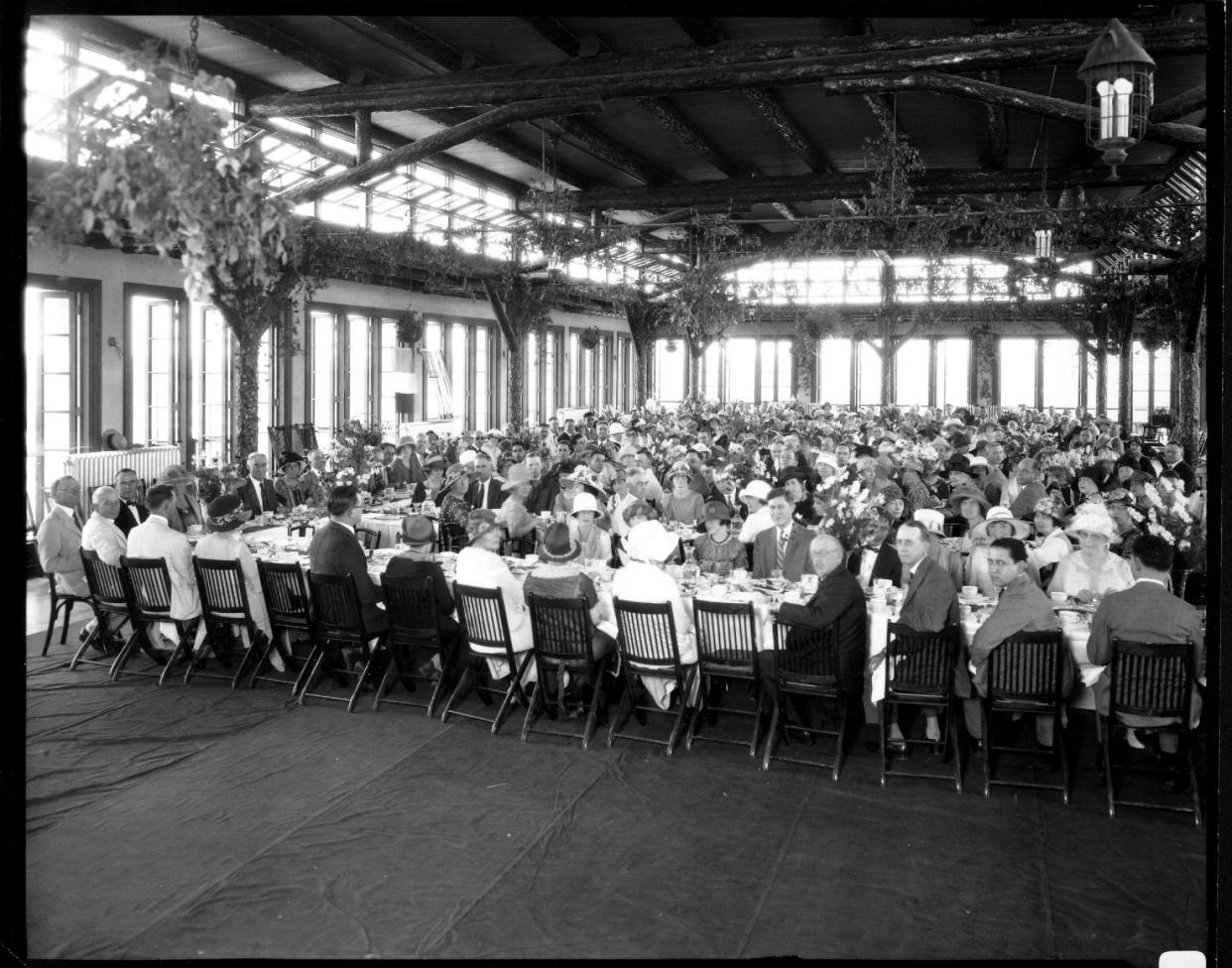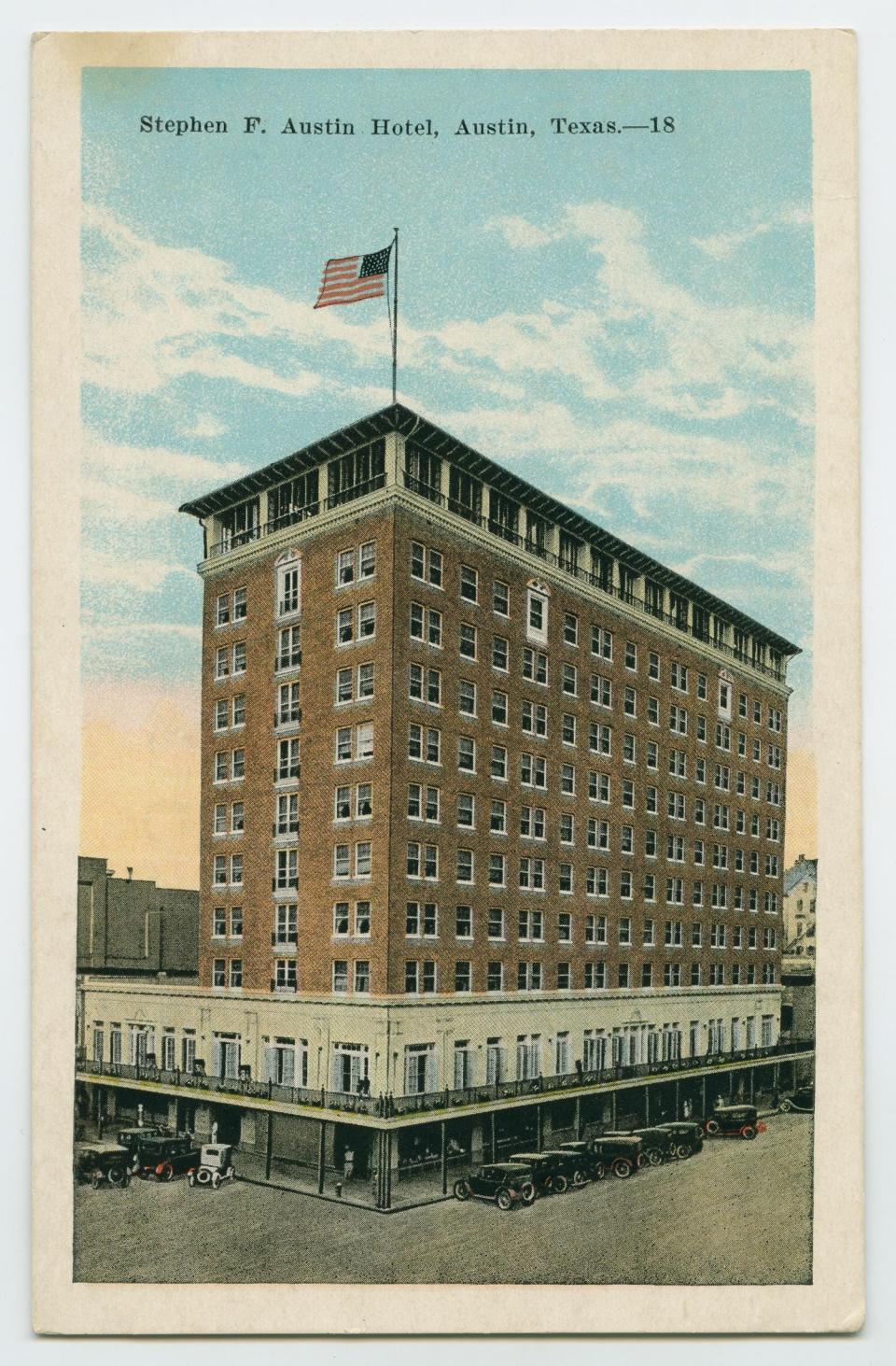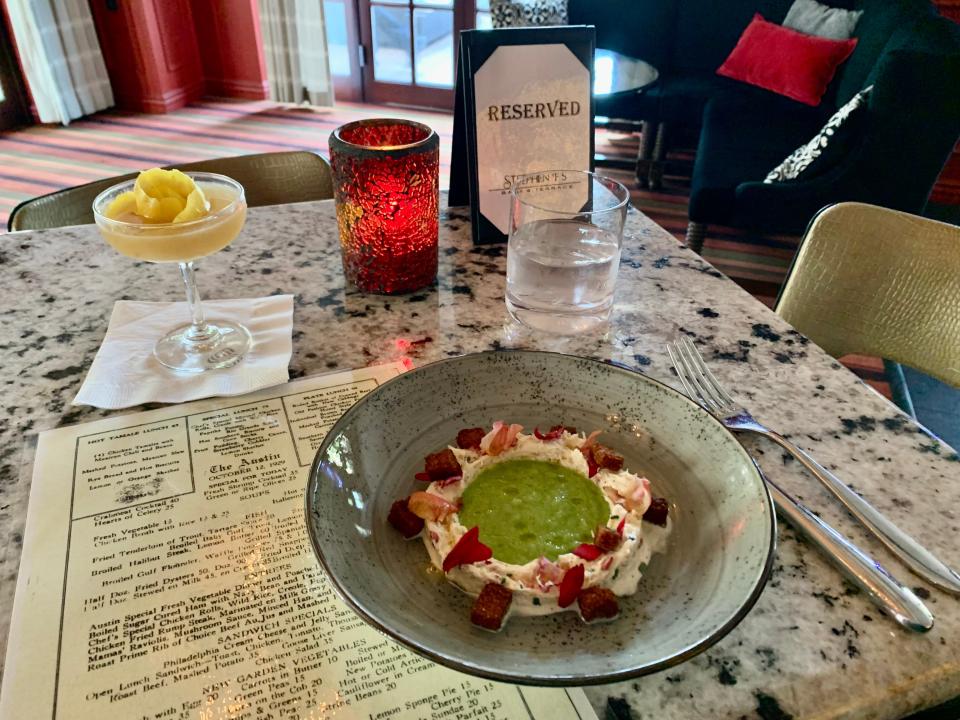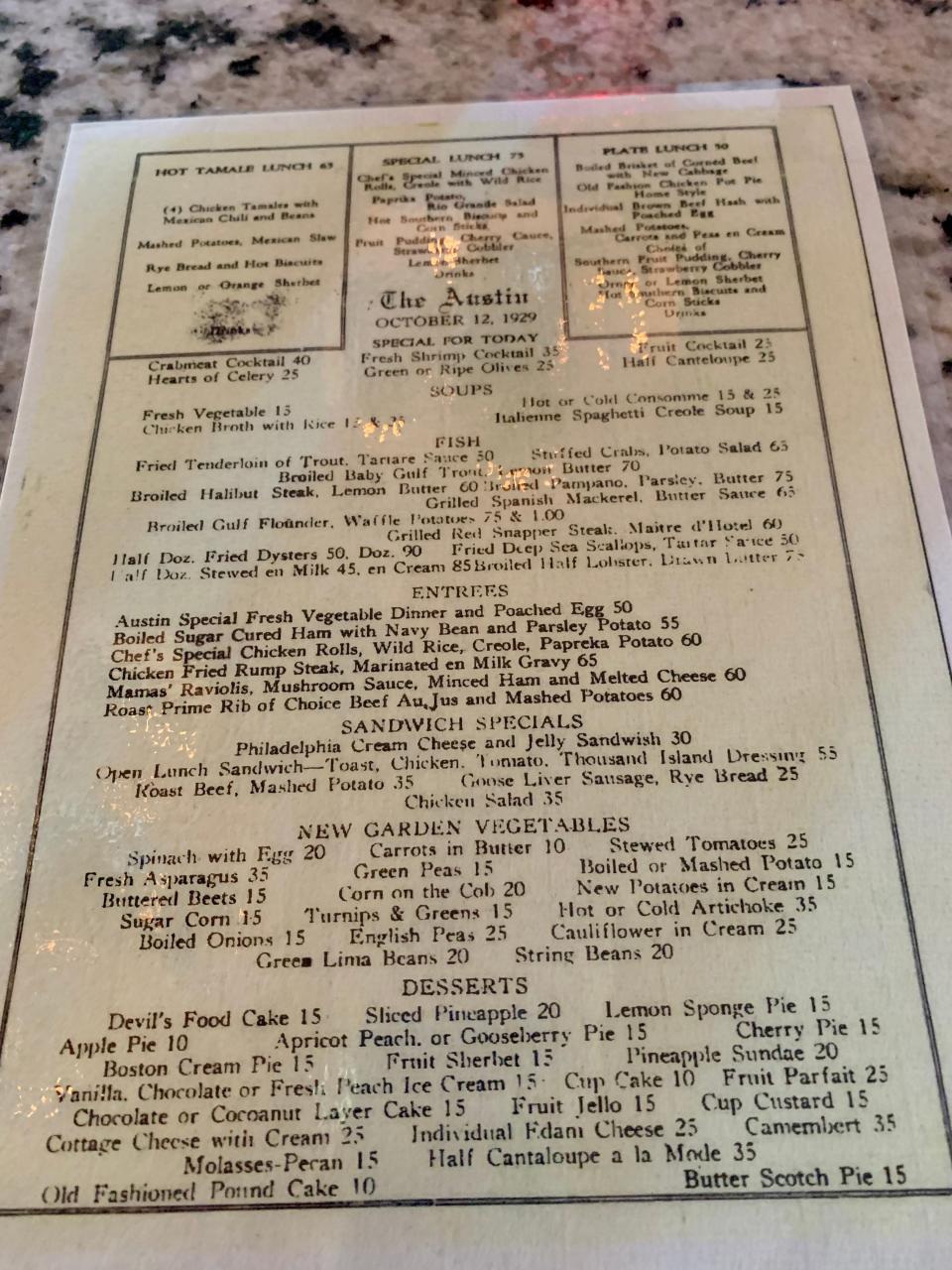What happened to the roof garden? Stephen F. Austin Hotel turns 100: What you should know.

The Stephen F. Austin Hotel turns 100 this year.
The handsome 1924 tower at Congress Avenue and East Seventh Street has always been somewhat overshadowed in the popular consciousness by the older and more ornate Driskill Hotel, which opened around the corner at Sixth and Brazos streets in 1886.
Now part of the Royal Sonesta chain — and slated for another phase of refurbishment — the Stephen F. Austin has hosted its share of celebrities, politicians, artists, conference-goers and tourists. Located close to the social action and associated with a series of tantalizing restaurants and bars, it has remained a key part of the downtown scene for a full century.
What happened when the Stephen F. Austin Hotel opened May 19, 1924?
"Beauty and Comfort Dominant Features of Palatial Hostelry" proclaims the headline in the May 18, 1924 American-Statesman, the day before the Stephen F. Austin opened. Almost the entire front page of the Sunday paper was reserved for this sort of boosterism, including a profile of its chief backer, T.B Baker: "From Bootblack to Millionaire Hotel Builder."
Plans for the hotel, part of the Baker Hotel chain, grew out of decades of intended civic improvement led by the Progressive movement. Progressives called for more city utilities, amenities, parks, schools, clinics, libraries, theaters and improvement clubs, especially women's clubs — although, in a time of undisguised racism, more for some of the population than others. They also wanted more hotel rooms for tourists, shoppers and convention-goers. The newspaper pinpointed a meeting 15 years prior to the opening that had planted the seed for the Stephen F. Austin.
More: Think Texas heads to Nacogdoches. Here's our itinerary for the 'oldest town in Texas'
The hotel, which included a French-chef-run restaurant, coffee shop, pharmacy, roof garden and barber shop, opened May 19 to music, dancing and a supper. The newspaper reported with gushing enthusiasm every elaborate detail of the hotel and its festivities, using a familiar style of the time that compared the Stephen F. Austin to the "loveliest and most comfortable" hotels in the Southwest, if not the whole country.
Wait. The hotel had a roof garden space? What happened to it?
One of the earliest photographs of the Stephen F. Austin, dated May 31, 1924, shows an enormous seated banquet in the 11th-floor covered roof garden, sometimes referred to as the "Longhorn Ballroom." Before widespread air-conditioning, American hotels, theaters and other public spaces of this era often included such a rooftop amenity to capture the summer breezes and allow guests to gather in large groups without wilting altogether.
More: Revisit Congress Avenue in 1914, where revelers in cars crowd out horse drawn buggies
The roof garden with its 125 windows was replaced in 1937 by a five-story, 150-room addition that brought the hotel's capacity to 350. As reported in the American-Statesman for Sunday, Dec. 26, 1937 under the headline "New $450,000 Improvement Program to Austin Hotel Completed," it was by this time the third largest hotel operated by the National Hotels system of Galveston, which was controlled by the same Moody family whose name graces so many public spaces in Austin.

Who were some of the celebrities who stayed there?
The very first guest to check in was Texas Gov. Pat Neff. Although Lyndon Baines Johnson and Lady Bird Johnson met for their first date at the Driskill Hotel coffee shop, and remained loyal to that landmark inn for political huddles and business meetings, LBJ sensed the news potential in being associated with the Stephen F. Austin as well. In a newsreel, LBJ is pictured showing FBI Director J. Edgar Hoover around the hotel.
More: 'An Echo of Belonging': Ebenezer Baptist Church commences 150th year of faith in Austin
Of course, lobbyists and legislators, once the backbone of Austin business, slept, played, dined or drank here. Artists, musicians and movie stars discovered the building, somewhat lost in the latter-day tower craze, many from their gigs at the Paramount and State theaters next door. The hotel was featured in "Miss Congeniality," "Grindhouse" and "Machete," and, more recently, Stephen F's Bar and Terrace became the de facto after-hours hangout for Moontower Comedy.
What were the hotel rivals to the Stephen F. Austin?
By the late 19th century, Austin had outgrown the early rough arrangements offered at places such as the Bullock Hotel and Eberly House. During the 1880s, flush with money from the great cattle drives of the previous decade, rancher Jesse Driskill opened his eponymous hotel on East Sixth and Brazos streets. A more modern tower annex was added to the north side of the 1886-era Driskill in 1930.
More: Who found that Treaty Oak was sick in 1989? Clue: She had view from her office window
Among the other downtown hotels, the 1950 Commodore Perry at East Eighth and Brazos streets, and the 1925 Alamo Hotel at West Sixth and Guadalupe streets, pop up frequently in historical references. The first held out as an alternative to the Driskill and the Austin, while the Alamo became seedier — and to some, more lovable — as the decades passed. Now the Commodore Perry holds condos, while rising from the former Alamo site is a mixed-used tower, Sixth & Guadalupe, that is, for the moment, the tallest in Austin.

What is the most iconic spot now at the Stephen F. Austin?
Stephen F's Bar and Terrace is among the most charming spots to meet in downtown.
Its balconies allow considerable views of the surrounding vistas, although those views have changed a great deal during the past few years. It takes a old-timer like myself a few minutes to adjust to the shifting landmarks, even though the west side of Congress Avenue in the 700 block retains its historical look. The presence of the replaced Paramount Theatre vertical sign remains front and center, as are new hotels to the north and south.
More: Did you go there? Help us name a lost Austin bar on East Sixth Street
If you grab a table early enough, it's the perfect place to watch a parade on Congress Avenue. Otherwise, it's a classy, relaxing bar with occasional bites staffed by alert and considerate servers. When I tarried there recently, I landed a front-row seat to set by jazz trumpeter Jeff Lofton.
What was on the menu at The Austin eatery in the 1920s?
Miraculously, an Oct. 12, 1929 menu for The Austin café has survived, which has inspired recent anniversary pop-up offerings that have included inventive craft cocktails and updated hotel dishes.
From the evidence of that menu, which ingredients were available in 1929?
Surprisingly, plenty of shrimp, crabmeat, trout, halibut, oysters, flounder, mackerel, scallops and lobster. Among the more expected regional dishes include sugar-cured ham, rump steak, chicken rolls, prime rib, liver and roast beef, along with plenty of fresh vegetables, corn and "hot southern biscuits." Mexican selections: hot tamale lunch with Mexican slaw. Desserts: gooseberry pie, southern fruit pudding, butterscotch pies and sliced pineapple.
Prices ranged from 15 cents to $3 for a sirloin steak.
"This is not food you'd typically be getting larger cities like New York," says current beverage director Matt Pawlak. "It's very southern style with sugar-cured ham and fried steak. The lobster might have come from Mexico or California."

Send your questions — or answers — about Central Texas past and present to "Austin Answered" at mbarnes@statesman.
This article originally appeared on Austin American-Statesman: Stephen F. Austin Hotel has plenty history. Find out what happened.

